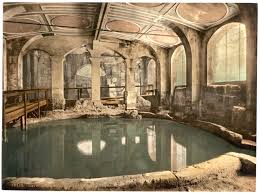To explain Roman Hygiene I have presented few facts below. I hope that it will suffice in explaining the exact system as it was in Rome.

Hygiene in ancient Rome included the famous public Roman baths, toilets, exfoliating cleansers, public facilities, and — communal toilet sponge notwithstanding — generally high standards of cleanliness.
Ancient Roman Hygiene
When trying to explain to children, students, readers, or friends what life was once like, nothing gets to the heart of the matter more poignantly than intimate details about daily life.
Telling young children that there were no televisions, movies, or radio, no electric or traffic lights, no refrigerators, or air conditioners, no cars, trains, or airplanes, doesn’t convey the “primitive” conditions nearly so well as explaining that instead of using toilet paper, they used a communal sponge — dutifully rinsed out after use.
Access to Toilets – Was it Good for Ancient Roman Hygiene?
“According to O.F. Robinson, Ancient Rome: City Planning and Administration, there were 144 public latrines in Rome in the later Empire. Apparently mostly concomitant of the public baths, which only makes sense as they could share water and sewerage.

There may have been a token payment if they were separate from the baths, she conjectures. She also writes that they were comfortable places, where one might sit and read, or otherwise “amuse oneself sociably,” hoping for [dinner] invitations. She cites a ditty by Martial:
Why does Vacerra spend his hours
in all the privies, and day-long sit?
He wants a supper, not a s**t.”
[Urine tax] “Public urinals consisted of buckets, dolia Curta. The contents were regularly collected and sold to the fullers for cleaning wool, etc. That’s where the tax story comes in. The fullers were the ones who were taxed. The collectors had public contracts and could be fined if late.”ROMAHOST
Access to Hygiene Facilities in Ancient Rome for the Rich
“Readings from The Visible Past, by Michael Grant, indicate that Roman Hygiene in the Roman World was limited to the rich and famous, except for those who could afford the public baths or thermals, as running water did not reach the poor’s tenements from the aqueducts; these lesser folks relieved themselves in pots or commodes which were emptied into vats located under staircases and these emptied into cesspools throughout the city.
The rich and famous, from the emperor on down, enjoyed running water in palaces and mansions from lead pipes connected to the aqueducts. At Pompeii, for instance, all houses except the poorest had water pipes fitted with taps, and the wastewater was piped away into sewer or trench.” ANDRESGRANA
Access to Hygiene Facilities in Ancient Rome for the Poor
“Florence Dupont (Daily Life in Ancient Rome) writes that it was for reasons of ritual that the Romans washed frequently. And she adds that “. . . even in very ancient times and even in the depth of the country, Romans, including women and slaves, would wash every day and would have a thorough bath on every feast day if not more often. At Rome itself, baths were taken daily.”According to her, the admission fee at public baths was one-quarter as. [Affordable for pretty much everyone.]
“Joachim Marquardt (Das Privatleben der Römer) writes that fees differed, mentions one-quarter to one as for men, but always one full as for women, and that children got in free. He also writes that life-long free baths might be bequeathed in wills. That in itself seems to stress the importance of bathing.” ROMAHOST
Ancient Roman Way of Cleaning Cloths
“I have read that the Romans learned of soap from the Germans some time in the first century CE, and that previous to that they used urine (ammonia) for clothes. Using the two in combination, of course, would be even more effective.

Urine was apparently treated in some way before use, but I do not know how. It may have been either a chemical process or a distillation.”RMARTINEK
Hair Care in Ancient Rome: Ancient Roman Hygiene
“Ovid’s advice on grooming includes hair removal and not just men’s beards. Whether this was accomplished by shaving, plucking or other depilatory practices is sometimes hard to tell. Julius Caesar was noted by Suetonius to have been meticulous in hair removal.

Seems he didn’t want hair anywhere except where he didn’t have it (the crown of his head, hence the famous comb-over).
“Not that hair is inherently dirty or stinks; but there was an aesthetic of cleanness, of refining the surface. I’ve read somewhere that pervasive hair removal was characteristic of Egyptian priests, maybe as a form of purification; for practical purposes, it reduces susceptibility to lice, for instance.” CYNWOLFE
Cleansers vs. Soap in the Ancient World
“A respondent later in this exchange reminded readers of the Roman use of olive oil, along with the strigil to exfoliate. Soap is mainly just processed fat. The Celts of Gaul are sometimes credited, I think by Pliny, with the invention of soap (Sapo) and may have used sheep tallow to make it. I’m not sure rubbing one’s body with a product made from the fat of slaughtered animals is inherently more aesthetic or clean than using olive oil.

“It occurs to me that sitting on the edge of my own bathtub is a commercially prepared exfoliating rub made from olive oil, coarse salt, and sage extract, which would have been quite at home in another of Ovid’s treatises, the one on making cosmetics.
And at my local holistic grocery store or international market, I can buy a gentle, emollient soap made from olive oil, to confuse the distinction between oil and soap further.



